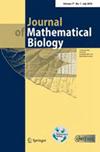多发性硬化症趋化模型的动力学理论推导及二维模式分析。
IF 2.3
4区 数学
Q2 BIOLOGY
引用次数: 0
摘要
本文给出了一类多发性硬化症的反应扩散方程。这些模型是从适当的动力学描述出发,考虑到细胞之间潜在的微观相互作用,通过扩散极限推导出来的。在宏观层面上,我们讨论了图灵不稳定现象和二维图形形成的必要条件,并通过弱非线性分析研究了二维图形的形状和稳定性。针对某一特定情况,提出了一些数值模拟,以证实和推广理论结果。本文章由计算机程序翻译,如有差异,请以英文原文为准。
Derivation from kinetic theory and 2-D pattern analysis of chemotaxis models for Multiple Sclerosis.
In this paper, a class of reaction-diffusion equations for Multiple Sclerosis is presented. These models are derived by means of a diffusive limit starting from a proper kinetic description, taking account of the underlying microscopic interactions among cells. At the macroscopic level, we discuss the necessary conditions for Turing instability phenomena and the formation of two-dimensional patterns, whose shape and stability are investigated by means of a weakly nonlinear analysis. Some numerical simulations, confirming and extending theoretical results, are proposed for a specific scenario.
求助全文
通过发布文献求助,成功后即可免费获取论文全文。
去求助
来源期刊
CiteScore
3.30
自引率
5.30%
发文量
120
审稿时长
6 months
期刊介绍:
The Journal of Mathematical Biology focuses on mathematical biology - work that uses mathematical approaches to gain biological understanding or explain biological phenomena.
Areas of biology covered include, but are not restricted to, cell biology, physiology, development, neurobiology, genetics and population genetics, population biology, ecology, behavioural biology, evolution, epidemiology, immunology, molecular biology, biofluids, DNA and protein structure and function. All mathematical approaches including computational and visualization approaches are appropriate.

 求助内容:
求助内容: 应助结果提醒方式:
应助结果提醒方式:


